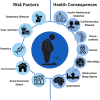Therapeutic advances in obesity management: an overview of the therapeutic interventions
- PMID: 38715796
- PMCID: PMC11074390
- DOI: 10.3389/fendo.2024.1364503
Therapeutic advances in obesity management: an overview of the therapeutic interventions
Abstract
Obesity has become a global epidemic in the modern world, significantly impacting the global healthcare economy. Lifestyle interventions remain the primary approach to managing obesity, with medical therapy considered a secondary option, often used in conjunction with lifestyle modifications. In recent years, there has been a proliferation of newer therapeutic agents, revolutionizing the treatment landscape for obesity. Notably, glucagon-like peptide-1 receptor agonists (GLP-1 RAs), such as semaglutide, liraglutide, and the recently approved dual GLP-1/GIP RAs agonist tirzepatide, have emerged as effective medications for managing obesity, resulting in significant weight loss. These agents not only promote weight reduction but also improve metabolic parameters, including lipid profiles, glucose levels, and central adiposity. On the other hand, bariatric surgery has demonstrated superior efficacy in achieving weight reduction and addressing overall metabolic imbalances. However, with ongoing technological advancements, there is an ongoing debate regarding whether personalized medicine, targeting specific components, will shape the future of developing novel therapeutic agents for obesity management.
Keywords: GLP-1 RAs; bariatric; obesity; tirzepatide; weight loss.
Copyright © 2024 Roomy, Hussain, Behbehani, Abu-Farha, Al-Harris, Ambi, Abdalla, Al-Mulla, Abu-Farha and Abubaker.
Conflict of interest statement
The authors declare that the research was conducted in the absence of any commercial or financial relationships that could be construed as a potential conflict of interest. The author(s) declared that they were an editorial board member of Frontiers, at the time of submission. This had no impact on the peer review process and the final decision.
Figures
References
-
- Purnell JQ, Feingold K, Anawalt B, Blackman M, Boyce A, Chrousos G, et al. . Definitions, classification, and epidemiology of obesity. In: Feingold KR, Anawalt B, Blackman MR, Boyce A, Chrousos G, et al., editors. Definitions, classification, and epidemiology of obesity. Endotext. South Dartmouth MA: (2000).
-
- Weir CB, Jan A. BMI classification percentile and cut off points. In: StatPearls. Treasure Island FL: StatPearls Publishing. (2023). ineligible companies. Disclosure: Arif Jan declares no relevant financial relationships with ineligible companies. - PubMed
Publication types
MeSH terms
Substances
LinkOut - more resources
Full Text Sources
Medical



